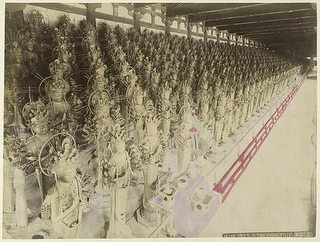Sanjusangendo
- Built: 1164, Taira no Kiyomori
- Popular Name: 三十三間堂 (san juu san gen dou)
- Formal Name: 蓮華王院本堂 (renge ou in hondou)
The Sanjûsangendô (lit. "Hall of 33 Bays") is a Buddhist temple of the Tendai sect located in Kyoto. It was built by Taira no Kiyomori for Former Emperor Go-Shirakawa and finished in 1164 . It is thirty-three bays (ken) long (about 120 meters) and four bays deep, the width of "bays," i.e. the space between the pillars in a building, being standardized in traditional Japanese architecture at a distance equal to roughly 1.8 meters.
The temple was originally founded in 1132 as part of the Myôhô-in temple, though it was not formally completed until 1164. The temple was then rebuilt in 1251-1256.
Due to the great length of the hall, its exterior porch has long been the site of archery competitions. The competition centered not on hitting a bull's eye or other target with exceptional precision or accuracy, but rather on firing as many arrows as possible within a limited time, and on having as many of those arrows as possible fly the full length of the hall without striking the floor, walls, pillars, or ceiling of the porch. The standing record dates back to 1686, when a competitor is said to have loosed 13,053 arrows down the length of the building, of which 8,133 were successfully shot the full length of the building without touching it.
The hall contains a large gilded central sculpture of the "1000-armed" Kannon (the 1000 arms are represented by 42 arms in the statues), flanked by 1000 smaller 1000-armed Kannon, along with figures of twenty-eight other various Buddhist deities. The building, and many of the sculptures, were severely damaged during the Genpei War (1180-1185); the sculptures created in the early 13th century by Tankei and other members of the Kei school to replace those lost are often cited as some of the greatest surviving examples of Kamakura period sculpture. Repair and restoration work on the one thousand statues, begun in 1936-1956, and resumed in 1973, continues to be ongoing. As of April 2015, 898 of the statues have been repaired, and the project is nearing completion.[1] Though long designated Important Cultural Properties, the 1000 Kannon statues were upgraded to National Treasures in 2018. The large central Kannon figure, its 28 attendants, and the paired statues of Fûjin and Raijin are also all regarded as National Treasures.
An earthenwork wall in the Sanjûsangendô compound is counted among the Three [Great] Earthenwork Walls of Japan, alongside one built by Oda Nobunaga at Atsuta Shrine in Nagoya, and one at Nishinomiya Shrine.
References
- Ching, Francis D.K. et al. A Global History of Architecture. Second Edition. John Wiley & Sons, 2011. p398.
- Japan Chronik
- Frederic, Louis (2002). "Renge-ō-in." Japan Encyclopedia. Cambridge, Massachusetts: Harvard University Press.
- Sanjûsangendô Official Site
- ↑ "Decades-long restoration of ancient 1,000 Kannon statues nearing completion," Asahi Shimbun, 1 April 2015.

